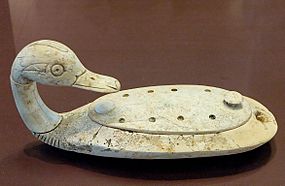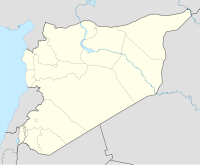- Minet el-Beida
-
Minet el-Beida
المينا البيضا
Duck container found at Minet el-Beida. Alternate name Ma'hadu Location Latakia, Syria Coordinates 35°36′25″N 35°46′34″E / 35.607°N 35.776°E Type settlement, port History Founded late fifteenth century BC Periods Bronze Age Cultures Canaanite Satellite of Ugarit Events Bronze Age collapse Site notes Excavation dates 1928—1935 Archaeologists Claude F. A. Schaeffer Ownership Public Public access No Minet el-Beida (Arabic: المينا البيضا, The White Harbor; or ancient Ma'hadu) is a small bay located 10 kilometers (6.2 mi) north of Latakia, Syria on the Mediterranean Sea. It is an important archaeological site because it served as the harbor town and necropolis for Ugarit.
Contents
Overview
Minet el-Beida takes its name from the white rocks at the entrance of the bay.[1] Located 1 kilometre (0.62 mi) west from Ugarit, the bay is the best natural port along that entire stretch of the coastline.[2] The bay is now smaller than it was in the Bronze Age, because of the action of the alluvial fill.[3]
The town was first settled in the late fifteenth century BC. The town plan resembles that of Ugarit, with irregular streets. Houses consisted of a courtyard surrounded by rooms, a well and an oven. Some houses contained underground tombs. The port town also had storehouses used for goods both imported or awaiting export. One such storehouse had 80 shipping jars still preserved inside.[3] The site witnessed the first great entrepôt for international overseas trade with the Aegean and beyond, and with the central Mediterranean.[4]
Excavation
It was the 1928 chance discovery in Minet el-Beida that prompted the excavation of the site and later of Ugarit (modern Ras Shamra). The discovery happened when a local farmer was attempting to plough his land and his ploughshare struck a large piece of stone which turned out to be one of a number of stone slabs which formed the roof of a vaulted tomb.[1]
Claude F. A. Schaeffer led the French excavation team at Minet el-Beida. The site was immediately recognized to be the main port for the Kingdom of Ugarit. It was the object of archaeological exploration until 1935 when it was abandoned in order to concentrate all efforts on Ras Shamra.[5]
Finds at the site indicate that Ugaritians formed the main element in the population, but with a large number of foreigners including Egyptians, Cypriots, Hittites, Hurrians, and people from the Aegean. Remains found at the site included, Cypriot pottery both imported and locally made; ivory cosmetic boxes from Egypt; Mycenaean pottery; bronze weapons and tools; cylinder seals and inscribed tablets.[3]
References
Bibliography
- Watson, Wilfred G. E.; Wyatt, Nicolas (1999). Handbook of Ugaritic studies, Part 1, Volume 39. BRILL. ISBN 9789004109889. http://books.google.com/books?id=0Z2Jo01iq1YC&pg=PA5&dq=Minet+el-Beida&ei=97WhS5TBC5zKlAS9jdzsCQ&cd=1#v=onepage&q=Minet%20el-Beida&f=false.
- Younger, K. Lawson (2007). Ugarit at Seventy-Five. EISENBRAUNS. ISBN 9781575061436. http://books.google.com/books?id=3xbHT7ZiAtUC&pg=PA103&dq=minet+el-beida&lr=&as_brr=3&ei=v9ShS8H5A6aMkAT4kqTnBA&cd=39#v=onepage&q=minet%20el-beida&f=false.
- Gates, Charles (2003). Ancient cities: the archaeology of urban life in the Ancient Near East and Egypt, Greece and Rome. Routledge. ISBN 9780415121828. http://books.google.com/books?id=7K1gw8cS33UC&pg=PA159&dq=minet+el-beida&lr=&as_brr=3&ei=WbyhS7zMGILmlQST69iuCQ&cd=20#v=onepage&q=minet%20el-beida&f=false.
- Hansen, Mogens Herman (2000). A comparative study of thirty city-state cultures: an investigation. Kgl. Danske Videnskabernes Selskab. ISBN 9788778761774. http://books.google.com/books?id=8qvY8pxVxcwC&pg=PA90&dq=minet+el-beida&lr=&as_brr=3&ei=v9ShS8H5A6aMkAT4kqTnBA&cd=38#v=onepage&q=minet%20el-beida&f=false.
See also
Categories:- Former populated places in Syria
- Bays of Syria
- Ugarit
- Archaeological sites in Syria
Wikimedia Foundation. 2010.

